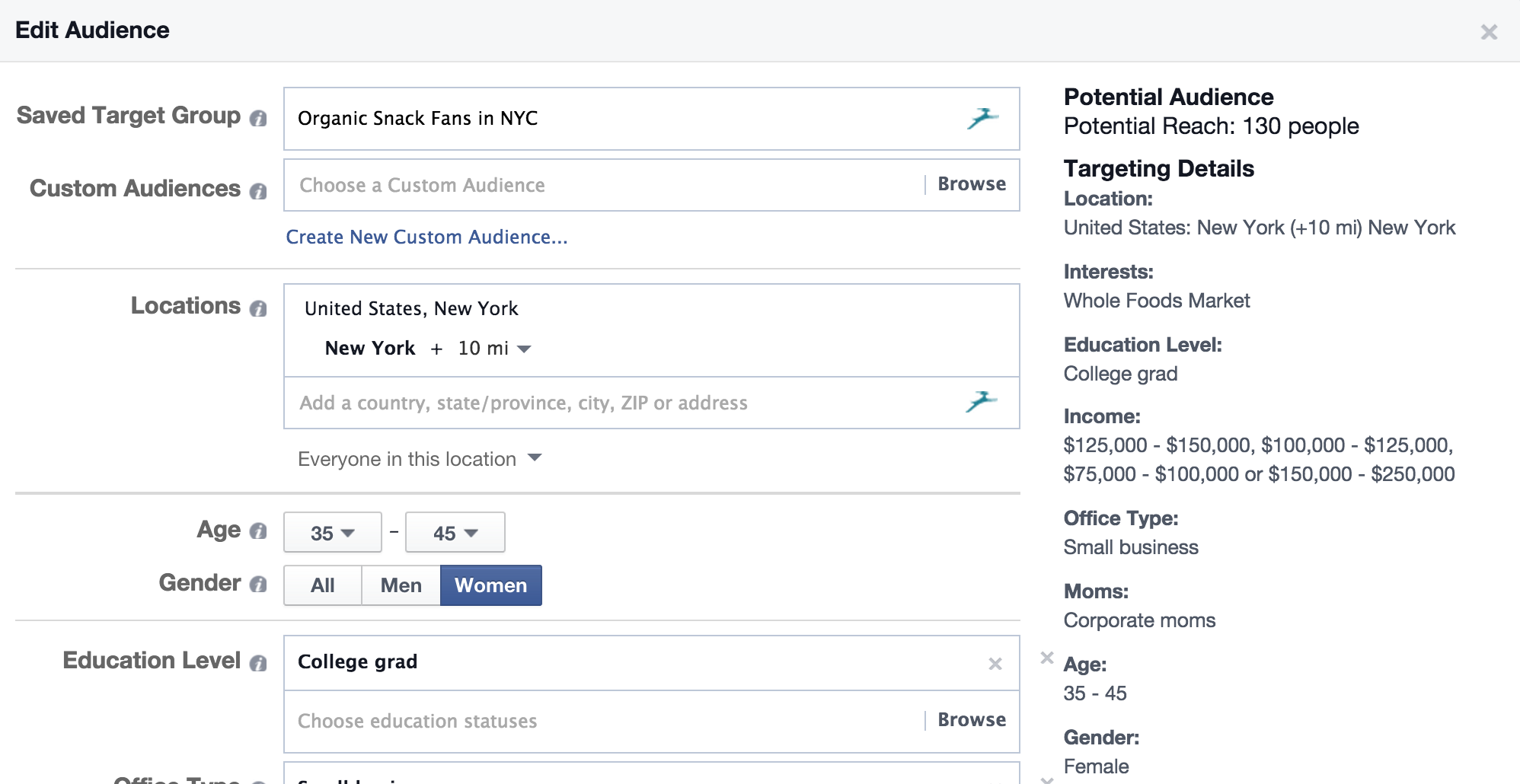There’s a big problem with the way the majority of businesses are using Facebook.
Most businesses, startups, and nonprofits have a Facebook page, and, as common sense would tell you, you should. With 1.44 billion people around the globe using Facebook on a monthly basis, your business should be getting its name out there too, right?
The problem is that most organizations approach marketing on Facebook all wrong. They spend valuable time creating content and posting on Facebook to gain likes, comments, and shares—this strategy simply isn’t working anymore.
The problem is that most organizations approach marketing on Facebook all wrong. Tweet This Quote
According to a study by Locowise, which analyzed 500 pages throughout February totaling more than 215 million likes and 27,000 posts, organic reach was found to be between 7-11percent—meaning only a small fraction of your total followers have the opportunity to see the content you’re posting, and a small fraction of those actually engage with it.
And it’s only going to get worse. Brian Boland, Facebook’s VP of Advertising Technology, has gone on record saying organic content will become increasingly less effective as an engagement tool.
Your News Feed only has so much real estate, and each day there are more people and brands posting more and more content. The natural result is that each post has less exposure to each individual.
Facebook has made it clear that free, reliable access to its users is coming to an end Tweet This Quote
All that said, Facebook is still a superbly powerful and increasingly relevant tool for online marketing—if used correctly. The future of marketing on Facebook requires a drastically different mindset and approach.
Facebook has made it clear that free, reliable access to its users is coming to an end—so if you want your organization to continue to have a presence there, prepare to allocate an advertising budget to it.
1. Be very, very specific about whom you advertise to.
What makes Facebook such a powerful tool for marketing is its ability to hone in on a hyper-niche segment of its massive global user base.
For nearly ten years, Facebook has been collecting data on every user—from the information on their profile to every organization, book, brand, celebrity, and interest liked. And through its mobile network and partners, Facebook has aggregated volumes of data on things like your income and net worth, loan history, purchasing patterns, ethnic affinity, political views, charity donation activities, and travel preferences.
Privacy concerns aside, what makes this exciting is that as an advertiser on Facebook, you can use this data to define a very, very specific audience that is primed to be a good fit for the product or service you offer.

For example, if you work for a startup that makes premium, organic, sustainably made snacks, and you know that affluent female professionals are your best customers, you can tell Facebook to show your content only to women who are between the ages of 35-45, who have Bachelor’s degrees and earn $75,000 a year or more, have kids, live in a particular neighborhood in your local area, like the store “Whole Foods,” and work in an office job.
Facebook’s targeting takes it even further. Upload a newsletter email list and choose to include or exclude people in ad campaigns; include or exclude people who have “liked” your page; or track website visitors that saw (or didn’t see) a particular page and target them.
By combining demographic data, personal preferences, online behavior, and previous engagement with your brand or website, you can design the perfect audience to show your content to. And as an advertiser, your ability to reach them doesn’t depend on them having “liked” your page in the past.
No other advertising tool or platform in history has offered small organizations this level of sophistication and precision—the vast majority of businesses out there aren’t taking advantage of its full power.
2. Don’t treat Facebook like a sales tool.
Facebook does not exist for the purpose of selling products and services. If you treat it like a commercial platform, your campaigns are almost guaranteed to lose money.
People don’t log into Facebook to make buying decisions. We go to Facebook to be entertained Tweet This Quote
Aside from failing to target properly, the most common mistake that businesses make on Facebook is treating it like a common advertising channel. Why? People don’t log into Facebook to make buying decisions. We go to Facebook to be entertained; to share what’s happening in our lives; and to connect with people we know—to distract ourselves from doing more productive things.
We are not there with a buyer’s mindset, credit card in hand. And the last thing we want to do on Facebook is make decisions.
Given the never-ending stream of content and our ability to scroll past uninteresting posts in a fraction of a second, typical ads that attempt to sell things directly don’t stand a chance of being read or clicked. Being smart about targeting helps tremendously to reach an audience that will find your product or service relevant, but you need to take it a step further.
Tip #3. Add Value First.
Here’s a good rule of thumb for success on Facebook: your ads should add to the user experience, not take away from it.
Your ads should add to the user experience, not take away from it. Tweet This Quote
Ads that say things like “check out our new product!” or “now available for only $79.99!” are very obviously designed for the seller’s benefit, not the reader’s—they take our attention without giving us anything positive in return.
Smart Facebook advertisers respect the context by creating ads that look like—and genuinely are—interesting content. This could take the form of text, photos, videos, or links to articles and webpages, but the bottom line is that the ad itself should serve the viewer in some way. Ads should be designed to entertain, inspire, educate, inform, excite, amaze, shock—do something that will catch a user’s attention while they’re thumbing through the News Feed at lightning speed.
If the audience is pleasantly surprised by what they find the first time they click on an ad, they’ll be much more likely to engage next time. If consistently delivered, they will come to see you as a giver, not a taker; and that is the beginning of a relationship that breeds trust, and eventually sales.
Tip #4. Know What You’re Doing with Those Clicks
We can’t justify spending money to show people great content unless it actually contributes to sales and generates a positive ROI.
After pinpointing your ideal audience and creating engaging ad content, your job is to get them to take action. Since people on Facebook are not in the mindset of making buying decisions, the best course of action is to take them off of Facebook.
If your goal is to generate sales, don’t pitch your product on Facebook. Tweet This Quote
If your goal is to generate sales, don’t pitch your product on Facebook. Instead, get them to click on your ad, take them to your website—whether it’s a “landing page,” a blog post, or a specific product page (just make sure it relates back to the original ad)—and consider how you can most effectively make the sale from there.
Think through these steps carefully like a chess master planning his moves—what happens after people click the ad makes all the difference between a money-losing campaign and a money-making campaign.
The right approach will vary depending on the business. The most effective place to make the sale could be over email (newsletter or sequence of automated emails), phone, or directly on your online store. People will often not buy the first time they click on an ad and visit a site, especially if they haven’t heard of or engaged with that content before. So it’s critical to find ways to keep them engaged after their first visit by capturing their contact information, and offering a compelling reason to follow up with them.
If not done right, Facebook will drain a business’s resources. Tweet This Quote
This may sound like a lot more work than you’re used to putting into Facebook—and it is. Anyone can post free content, get some likes and comments, and build a “following”—though the data makes it abundantly clear that people aren’t actually following brands on Facebook anymore.
Getting people to exchange money with you is a completely different matter. It requires a carefully thought-through strategy; a nuanced understanding of who your customers are and what they care about; building trust and credibility with them; and taking them through an intentional series of steps and experiences that get them warmed up and ready to buy.
If not done right, Facebook will drain a business’s resources. But those who put in the effort to learn how to make it work will gain a dominant presence in what is arguably the most popular place that people spend time online, and be able to create new customers at will.



